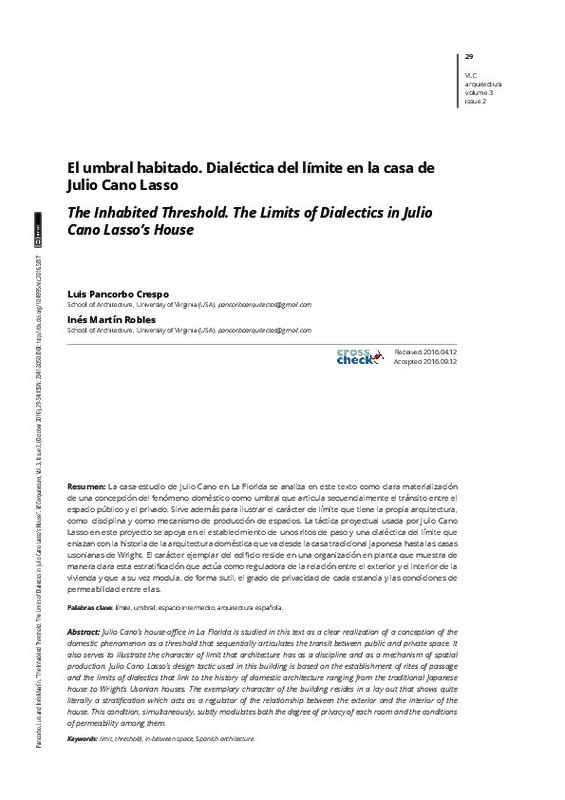JavaScript is disabled for your browser. Some features of this site may not work without it.
Buscar en RiuNet
Listar
Mi cuenta
Estadísticas
Ayuda RiuNet
Admin. UPV
The Inhabited Threshold. The Limits of Dialectics in Julio Cano Lasso’s House
Mostrar el registro sencillo del ítem
Ficheros en el ítem
| dc.contributor.author | Pancorbo Crespo, Luis
|
es_ES |
| dc.contributor.author | Martin Robles, Ines
|
es_ES |
| dc.coverage.spatial | east=-3.8188705999999684; north=40.4738659; name=El Plantío, 28023 Madrid, Espanya | |
| dc.date.accessioned | 2016-11-03T09:16:02Z | |
| dc.date.available | 2016-11-03T09:16:02Z | |
| dc.date.issued | 2016-10-27 | |
| dc.identifier.issn | 2341-3050 | |
| dc.identifier.uri | http://hdl.handle.net/10251/73202 | |
| dc.description.abstract | [EN] Julio Cano’s house-office in La Florida is studied in this text as a clear realization of a conception of the domestic phenomenon as a threshold that sequentially articulates the transit between public and private space. It also serves to illustrate the character of limit that architecture has as a discipline and as a mechanism of spatial production. Julio Cano Lasso’s design tactic used in this building is based on the establishment of rites of passage and the limits of dialectics that link to the history of domestic architecture ranging from the traditional Japanese house to Wright’s Usonian houses. The exemplary character of the building resides in a lay out that shows quite literally a stratification which acts as a regulator of the relationship between the exterior and the interior of the house. This condition, simultaneously, subtly modulates both the degree of privacy of each room and the conditions of permeability among them. | es_ES |
| dc.description.abstract | [ES] La casa-estudio de Julio Cano en La Florida se analiza en este texto como clara materialización de una concepción del fenómeno doméstico como umbral que articula secuencialmente el tránsito entre el espacio público y el privado. Sirve además para ilustrar el carácter de límite que tiene la propia arquitectura, como disciplina y como mecanismo de producción de espacios. La táctica proyectual usada por Julio Cano Lasso en este proyecto se apoya en el establecimiento de unos ritos de paso y una dialéctica del límite que enlazan con la historia de la arquitectura doméstica que va desde la casa tradicional japonesa hasta las casas usonianas de Wright. El carácter ejemplar del edificio reside en una organización en planta que muestra de manera clara esta estratificación que actúa como reguladora de la relación entre el exterior y el interior de la vivienda y que a su vez modula, de forma sutil, el grado de privacidad de cada estancia y las condiciones de permeabilidad entre ellas | es_ES |
| dc.language | Español | es_ES |
| dc.language | Inglés | es_ES |
| dc.publisher | Universitat Politècnica de València | |
| dc.relation.ispartof | VLC arquitectura. Research Journal | |
| dc.rights | Reconocimiento - No comercial (by-nc) | es_ES |
| dc.subject | Threshold | es_ES |
| dc.subject | Limit | es_ES |
| dc.subject | Umbral | es_ES |
| dc.subject | Límite | es_ES |
| dc.subject | Espacio intermedio | es_ES |
| dc.subject | Arquitectura española | es_ES |
| dc.subject | Spanish architecture | es_ES |
| dc.subject | In-between space | es_ES |
| dc.title | The Inhabited Threshold. The Limits of Dialectics in Julio Cano Lasso’s House | es_ES |
| dc.title.alternative | El umbral habitado. Dialéctica del límite en la casa de Julio Cano Lasso | es_ES |
| dc.type | Artículo | es_ES |
| dc.date.updated | 2016-10-31T13:35:56Z | |
| dc.identifier.doi | 10.4995/vlc.2016.5817 | |
| dc.rights.accessRights | Abierto | es_ES |
| dc.description.bibliographicCitation | Pancorbo Crespo, L.; Martin Robles, I. (2016). The Inhabited Threshold. The Limits of Dialectics in Julio Cano Lasso’s House. VLC arquitectura. Research Journal. 3(2):29-53. https://doi.org/10.4995/vlc.2016.5817 | es_ES |
| dc.description.accrualMethod | SWORD | es_ES |
| dc.relation.publisherversion | https://doi.org/10.4995/vlc.2016.5817 | es_ES |
| dc.description.upvformatpinicio | 29 | es_ES |
| dc.description.upvformatpfin | 53 | es_ES |
| dc.type.version | info:eu-repo/semantics/publishedVersion | es_ES |
| dc.description.volume | 3 | |
| dc.description.issue | 2 | |
| dc.identifier.eissn | 2341-2747 | |
| dc.description.references | Cano Lasso, Julio. Cano Lasso. 1949-1995. Madrid: MOPU, 1995. | es_ES |
| dc.description.references | Mccarter, Robert. Aldo van Eyck. New Haven: Yale University Press, 2015. | es_ES |
| dc.description.references | Smithson, Alison. "Instructions to groups." In: CIAM '59 in Otterlo: Documents of Modern Architecture 1, edited by Oscar Newman. New York: Universe Books, 1961. | es_ES |
| dc.description.references | Pilgrim, R. B. (1986). Intervals («Ma») in Space and Time: Foundations for a Religio-Aesthetic Paradigm in Japan. History of Religions, 25(3), 255-277. doi:10.1086/463043 | es_ES |
| dc.description.references | Sergeant, John. Frank Lloyd Wright's Usonian Houses. The case for organic architecture. New York: Whitney library of Design, Watson and Guptill Publications, 1984. | es_ES |
| dc.description.references | Trias, Eugenio. Lógica del límite. Barcelona: Destino, 1991. | es_ES |
| dc.description.references | Wright, Frank Lloyd. The Natural House. New York: Horizon Press, 1954. | es_ES |








